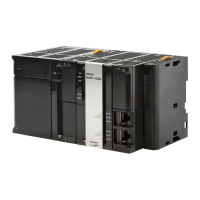3-5
3 I/O Ports, Slave Configuration, and Unit Configuration
NJ-series CPU Unit Software User’s Manual (W501)
3-2 Creating and Comparing the Slave and Unit
Configurations
3
3-2-1 Creating the EtherCAT Slave Configuration
3-2 Creating and Comparing the Slave
and Unit Configurations
To enable accessing the slaves and Units in the Controller, you create a Slave Configuration and a Unit
Configuration on the Sysmac Studio. You can also compare the Unit Configuration that was created on
the Sysmac Studio with the physical Unit configuration.
Use the Sysmac Studio Unit Editor to create the EtherCAT slave configuration that is detected as “cor-
rect” by the CPU Unit.
The I/O ports are automatically registered for the slaves in the configuration. Later, the user assigns
device variables to the I/O ports. You can specify device variables in the user program to access the
slaves.
Refer to EtherCAT Configuration and Settings in the Sysmac Studio Version 1 Operation Manual (Cat.
No. W504) for specific procedures to create the EtherCAT slave configuration.
If you connect EtherCAT Slave Terminals, create the EtherCAT slave configuration, create the
Slave Terminal configuration, and set the operation settings. Refer to the NX-series EtherCAT
Coupler Unit User’s Manual (Cat. No. W519) for information on the Slave Terminal configuration
and operation settings.
A CPU Unit with unit version 1.05 or later and Sysmac Studio version 1.06 or higher are required
to use EtherCAT Slave Terminals.
3-2-1 Creating the EtherCAT Slave Configuration
EtherCAT
EtherCAT
slave
CPU Unit
EtherCAT slave configuration
Created with the Sysmac Studio.
EtherCAT
slave
EtherCAT
slave
EtherCAT master

